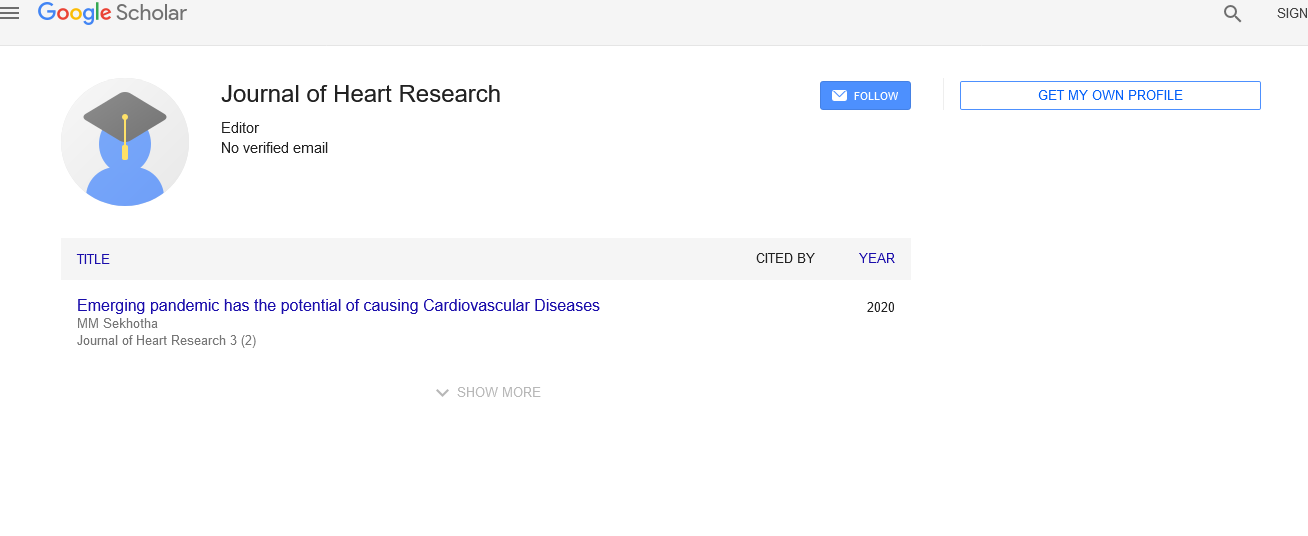study of congestive heart failure
Received: 03-Dec-2021 Accepted Date: Dec 17, 2021; Published: 24-Dec-2021, DOI: 10.37532/ puljhr.2022
This open-access article is distributed under the terms of the Creative Commons Attribution Non-Commercial License (CC BY-NC) (http://creativecommons.org/licenses/by-nc/4.0/), which permits reuse, distribution and reproduction of the article, provided that the original work is properly cited and the reuse is restricted to noncommercial purposes. For commercial reuse, contact reprints@pulsus.com
Commentary
Heart failure (HF), also known as congestive heart failure (CHF) and (congestive) cardiac failure (CCF), is a set of manifestations caused by the failure of the heart’s function as a pump supporting the blood flow through the body; its signs and symptoms result from a structural and/or functional abnormality of the heart, that disrupts its filling with blood or its ejecting of it during each heart beat. Signs and symptoms of heart failure commonly include shortness of breath, excessive tiredness, and leg swelling. The shortness of breath is usually worse with exercise or while lying down, and may wake the person at night. A limited ability to exercise is also a common feature. Chest pain, including angina, does not typically occur due to heart failure.
Common causes of heart failure include coronary artery disease, including a previous myocardial infarction (heart attack), high blood pressure, atrial fibrillation, valvular heart disease, excess alcohol use, infection, and cardiomyopathy of an unknown cause. These cause heart failure by changing either the structure or the function of the heart. The two types of left ventricular heart failure – heart failure with reduced ejection fraction (HFrEF or systolic heart failure), and heart failure with preserved ejection fraction (HFpEF or diastolic heart failure) – are based on whether the ability of the left ventricle to contract, or to relax, is affected. The severity of the heart failure is graded by the severity of symptoms with exercise.Heart failure is not the same as heart attack (in which part of the heart muscle dies due to a clot in the arteries supplying the heart) or cardiac arrest (in which blood flow stops altogether due to failure of the heart to pump effectively).Other diseases that may have symptoms similar to heart failure include obesity, kidney failure, liver problems, anemia, and thyroid disease. Diagnosis is based on symptoms, physical findings, and echocardiography. Blood tests, electrocardiography, and chest radiography may be useful to determine the underlying cause.
Treatment depends on the severity and cause of the disease. In people with chronic stable mild heart failure, treatment commonly consists of lifestyle modifications such as stopping smoking, physical exercise, and dietary changes, as well as medications. In those with heart failure due to left ventricular dysfunction, angiotensin converting enzyme inhibitors, angiotensin receptor blockers, or valsartan/sacubitric along with beta blockers are recommended. For those with severe disease, aldosterone antagonists, or hydralazine with a nitrate may be used. Diuretics are useful for preventing fluid retention and the resulting shortness of breath. Sometimes, depending on the cause, an implanted device such as a pacemaker or an implantable cardiac defibrillator may be recommended. In some moderate or severe cases, cardiac resynchronization therapy(CRT) or cardiac contractility modulation may be of benefit. A ventricular assist device (for the left, right, or both ventricles), or occasionally a heart transplant may be recommended in those with severe disease that persists despite all other measures.Heart failure is a common, costly, and potentially fatal condition, and it is the leading cause of both hospitalization and readmission amongst older adults. In 2015, it affected about 40 million people globally. Overall around 2% of adults have heart failure and in those over the age of 65, this increases to 6–10%. Rates are predicted to increase. The risk of death is about 35% the first year after diagnosis, while by the second year the risk of death is less than 10% for those who remain alive. This degree of risk of death is similar to some cancers. In the United Kingdom, the disease is the reason for 5% of emergency hospital admissions. Heart failure has been known since ancient times, with the Ebers papyrus commenting on it around 1550 BCE.
Acknowledgement
None
Conflict of Interest
None





